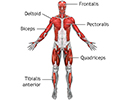Limb-girdle muscular dystrophies
Muscular dystrophy - limb-girdle type (LGMD)
Limb-girdle muscular dystrophies include at least 33 different inherited diseases. These disorders first affect the muscles around the shoulder girdle and hips. These diseases get worse over time. Eventually, it may involve other muscles.
Causes
Limb-girdle muscular dystrophies are a large group of genetic diseases in which there is muscle weakness and wasting (muscular dystrophy).
In most cases, both parents must pass on the non-working (defective) gene for a child to have the disease (autosomal recessive inheritance). In some rare types, only one parent needs to pass on the non-working gene to affect the child. This is called autosomal dominant inheritance. For most of these conditions, the defective gene has been discovered.
An important risk factor is having a family member with muscular dystrophy.
Symptoms
Most often, the first sign is pelvic muscle weakness. Examples of this include trouble standing from a sitting position without using the arms, or difficulty climbing stairs. The weakness starts in childhood to young adulthood.
Other symptoms include:
- Abnormal, sometimes waddling, walk
- Joints that are fixed in a contracted position (late in the disease)
- Large and muscular-looking calves (pseudohypertrophy), which are not actually strong
- Loss of muscle mass, thinning of certain body parts
- Low back pain
- Palpitations or passing-out spells
- Shoulder weakness
- Weakness of the muscles in the face (later in the disease)
- Weakness in the muscles of the lower legs, feet, lower arms, and hands (later in the disease)
Exams and Tests
Tests may include:
- Blood creatine kinase levels
- DNA testing (molecular genetic testing)
- Echocardiogram
- Electrocardiogram (ECG)
- Electromyogram (EMG) testing
- Muscle biopsy
- Pulmonary function tests
Treatment
There are no known treatments that reverse the muscle weakness. Gene therapy may become available in the future. Supportive treatment can decrease the complications of the disease.
The condition is managed based on the person's symptoms. It includes:
- Heart monitoring
- Mobility aids
- Physical therapy
- Respiratory care
- Weight control
Surgery is sometimes needed for any bone or joint problems.
Support Groups
The Muscular Dystrophy Association is an excellent resource: www.mda.org
Outlook (Prognosis)
In general, people tend to have weakness that slowly gets worse in affected muscles and spreads.
The disease causes loss of movement. The person may be dependent on a wheelchair within 20 to 30 years.
Heart muscle weakness and abnormal electrical activity of the heart can increase the risk for palpitations, fainting, and sudden death. Most people with this group of diseases live into adulthood, but do not reach their full life expectancy.
Possible Complications
People with limb-girdle muscular dystrophies may experience complications such as:
- Abnormal heart rhythms
- Contractures of the joints
- Difficulties with activities of daily living due to shoulder weakness
- Progressive weakness, which may lead to needing a wheelchair
When to Contact a Medical Professional
Contact your health care provider if you or your child feels weak while rising from a squatting position. Contact a geneticist if you or a family member has been diagnosed with muscular dystrophy, and you are planning a pregnancy.
Prevention
Genetic counseling is now offered to affected individuals and their families. Soon molecular testing will involve whole genome sequencing on patients and their relatives to better establish the diagnosis. Genetic counseling may help some couples and families learn about the risks and help with family planning. It also allows connecting patients with diseases registries and patient organizations.
Some of the complications can be prevented with appropriate treatment. For example, a cardiac pacemaker or defibrillator can greatly reduce the risk for sudden death due to an abnormal heart rhythm. Physical therapy may be able to prevent or delay contractures and improve quality of life.
Affected people may want to do DNA banking. DNA testing is recommended for those who are affected. This helps to identify the family gene mutation. Once the mutation is found, prenatal DNA testing, testing for carriers, and pre-implantation genetic diagnosis are possible.
References
Bharucha-Goebel DX. Muscular dystrophies. In: Kliegman RM, St Geme JW, Blum NJ, Shah SS, Tasker RC, Wilson KM, eds. Nelson Textbook of Pediatrics. 21st ed. Philadelphia, PA: Elsevier; 2020:chap 627.
Johnson NE, Statland JM. The limb-girdle muscular dystrophies. Continuum (Minneap Minn). 2022;28(6):1698-1714. PMID: 36537976 pubmed.ncbi.nlm.nih.gov/36537976/.
Muscular Dystrophy Association website. Limb-girdle muscular dystrophy (LGMD). www.mda.org/disease/limb-girdle-muscular-dystrophy. Accessed March 5, 2024.
Selcen D. Muscle diseases. In: Goldman L, Cooney KA, eds. Goldman-Cecil Medicine. 27th ed. Philadelphia, PA: Elsevier; 2024:chap 389.
Review Date: 12/31/2023









